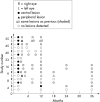The national neonatal screening programme for congenital toxoplasmosis in Denmark: results from the initial four years, 1999-2002
- PMID: 16861484
- PMCID: PMC2083029
- DOI: 10.1136/adc.2004.066514
The national neonatal screening programme for congenital toxoplasmosis in Denmark: results from the initial four years, 1999-2002
Abstract
Aims: To describe the outcome of four years' nationwide neonatal screening for congenital toxoplasmosis in liveborn newborns.
Methods: Congenital toxoplasmosis was diagnosed if specific Toxoplasma gondii IgM antibodies were detected in eluate from the PKU Guthrie filter paper card from a child. Infants diagnosed with congenital toxoplasmosis were examined for intracranial and retinal lesions and treated for three months with sulphadiazine, pyrimethamine, and folinic acid continuously.
Results: Eluates from PKU-cards from 262 912 newborns were analysed. The birth prevalence of congenital toxoplasma infection was 2.1 per 10 000 liveborns. Congenital toxoplasmosis was suspected in 96 infants and confirmed in 55. Forty seven children were examined for intracranial and retinal lesions soon after birth; 12 had clinical signs at this first examination. Of these, 5 had intracranial calcifications, 2 had retinochoroidal lesions, 4 had intracranial calcifications and retinochoroidal lesions, and 1 had hydrocephalus, intracranial calcifications, and retinochoroidal lesions. Ninety four eyes were examined soon after birth; there were central retinochoroidal lesions in 9. Two children had macular lesion of both eyes, five had macular lesions of one eye. At 1 year of age, 10/68 eyes had central lesions, and at 3 years of age, 5/32 had central lesions. Thus new retinochoroidal lesions developed in three eyes in the observation period.
Conclusions: Neonatal screening is feasible for diagnosing children with congenital toxoplasmosis at birth in low endemic areas. Retinochoroiditis with macular lesion was diagnosed in 9.6% of the eyes at birth and in 15.6% of the eyes examined at 3 years of age.
Conflict of interest statement
Competing interests: none declared
Comment in
-
Newborn screening for congenital toxoplasmosis: feasible, but benefits are not established.Arch Dis Child. 2006 Aug;91(8):629-31. doi: 10.1136/adc.2006.094870. Arch Dis Child. 2006. PMID: 16861480 Free PMC article.
References
-
- Koppe J G, Loewer‐Sieger D H, de Roever‐Bonnet H. Results of a 20‐year follow‐up of congenital toxoplasmosis. Lancet 1986i254–256. - PubMed
MeSH terms
Substances
LinkOut - more resources
Full Text Sources
Medical


